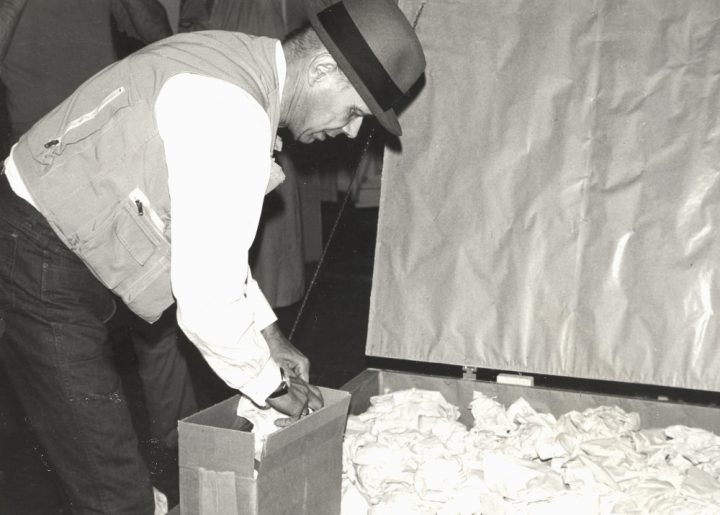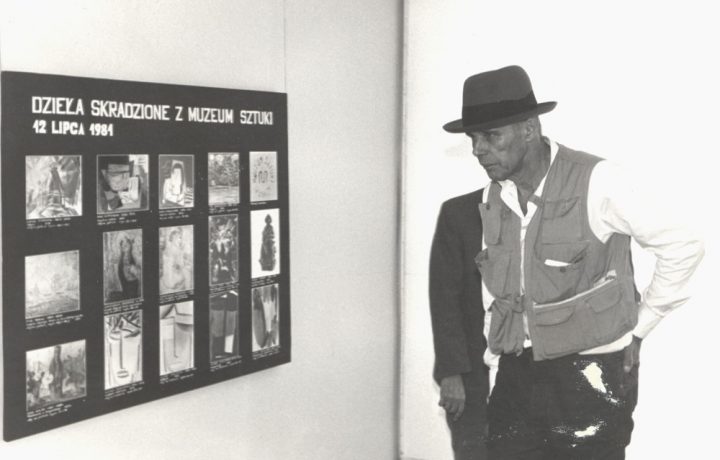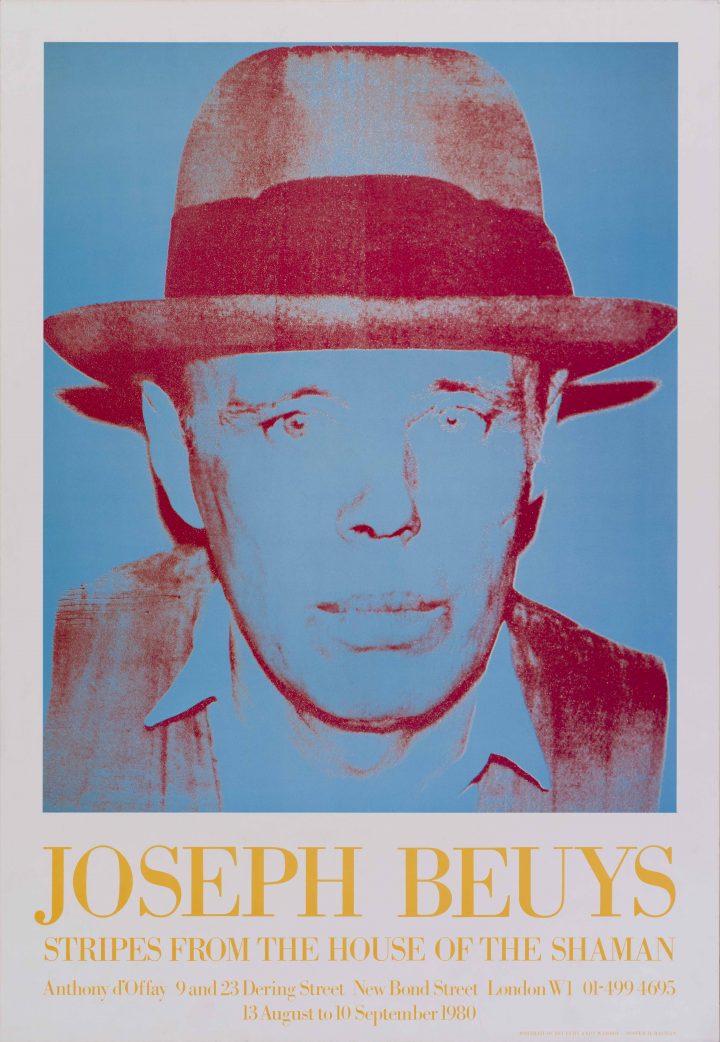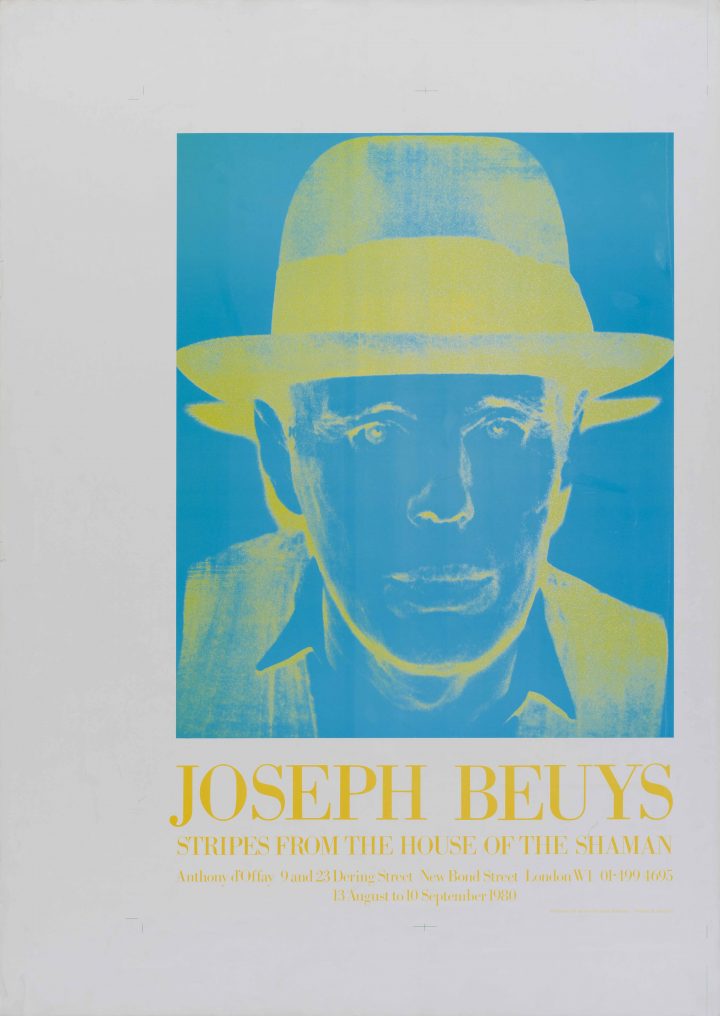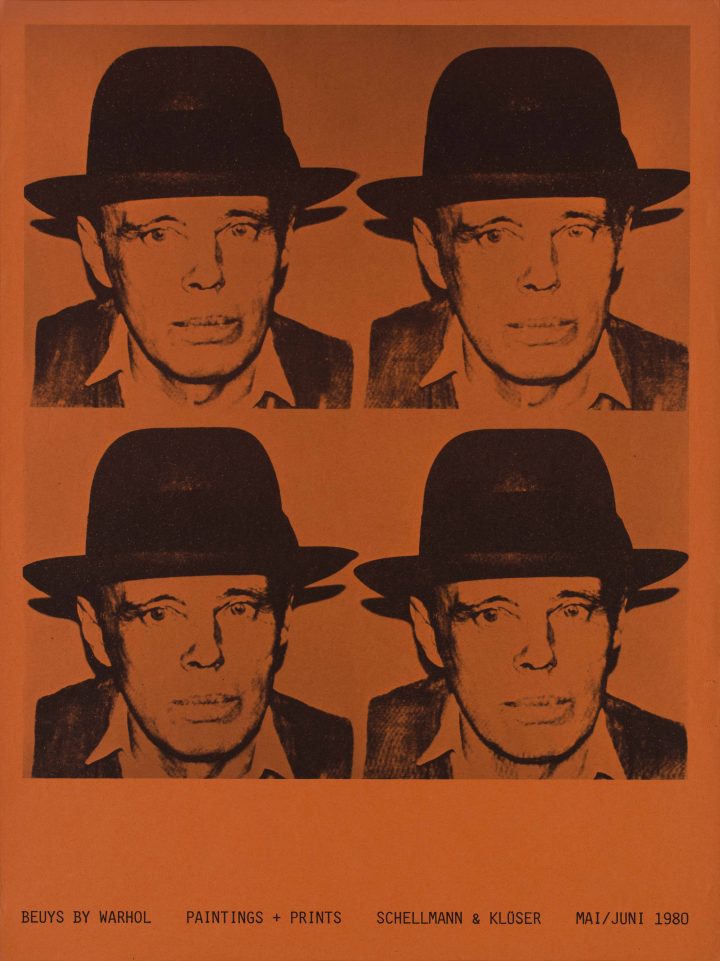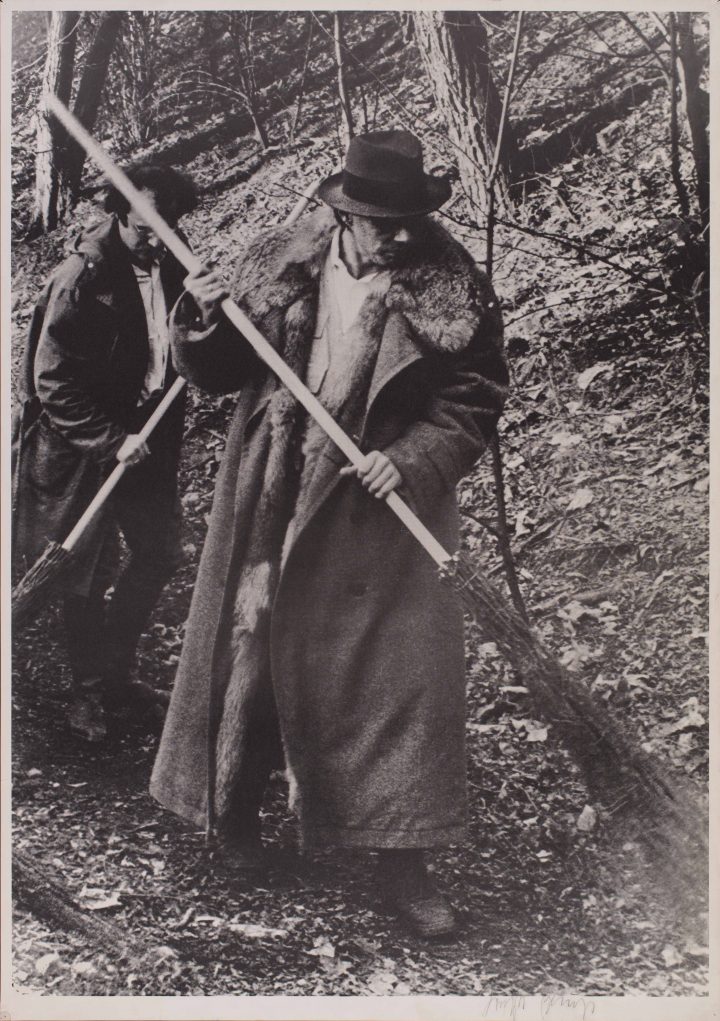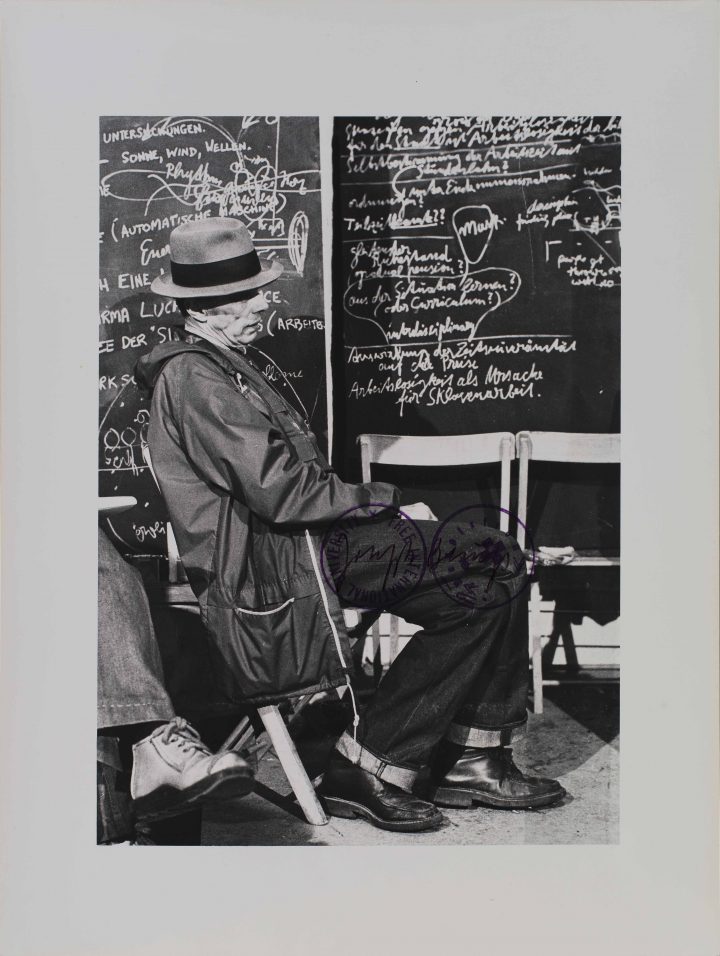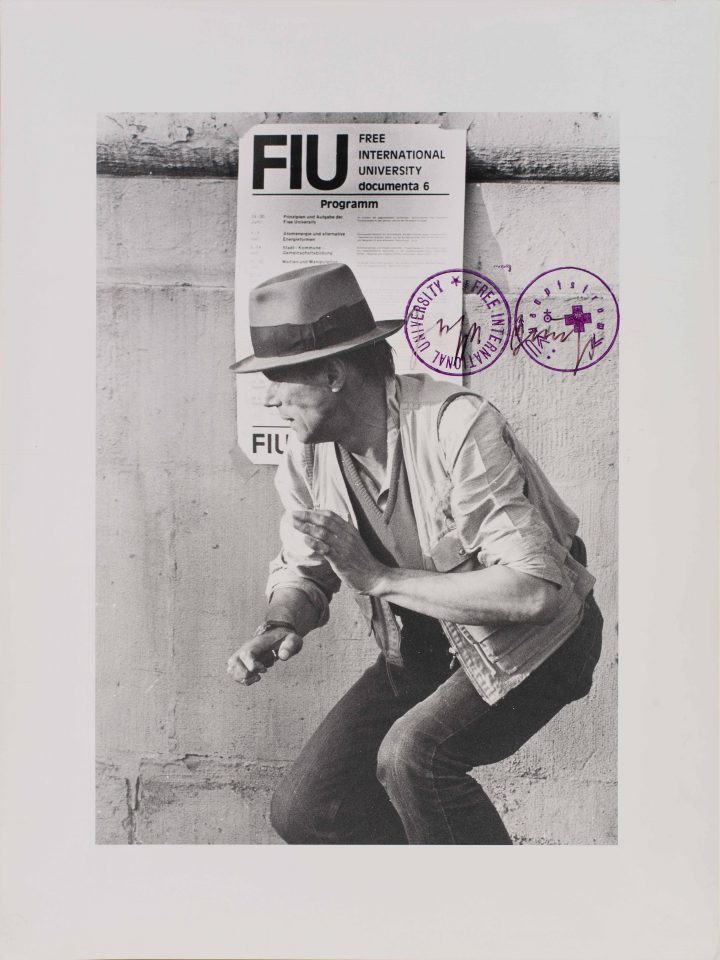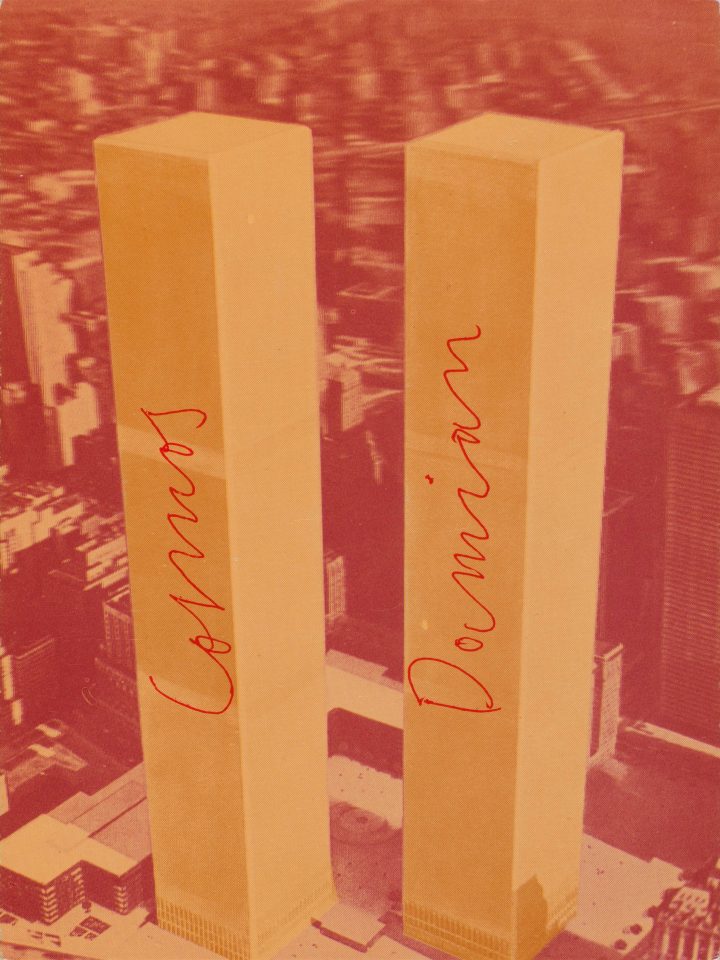Łukasz Zaremba
A Gift without Debt. Polentransport Performance by Joseph Beuys
Essay on performing an artistic persona by Joseph Beuys.
Published in: Joseph Beuys. Outside the Box, Espoo 2017
“If the other gives me back or owes me or has to give me back what I give him or her, there will not have been a gift, whether this restitution is immediate or whether it is programmed by a complex circulation of a long-term deferral or difference.”
Jacques Derrida
“When you cut your finger, bandage the knife.”
Joseph Beuys
In one of the photos documenting Joseph Beuys’s visit to the Muzeum Sztuki in Łódź in August 1981, the West German artist, accompanied by the museum’s director Ryszard Stanisławski, is examining an unusual framed panel. It contains photographs of objects from the museum’s collection, which had been stolen from the institution about a month before Beuys’s arrival. Under the cover of night, the artworks, among them a small sculpture by Renoir that has not been located to this day, were smuggled abroad. Thanks to the help of the Interpol agency, most of the works were quickly retrieved. A month after the robbery—and without any connection to it whatsoever—Joseph Beuys, then at the peak of his popularity, visited the museum, arriving to Łódź bearing gifts: his own artworks.
The theft of artworks from the museum’s collection is an act situated on the opposite end of the scale—a scale describing a circulation of objects—from Beuys’s actions in Łódź. The German artist’s visit to Łódź was planned and publicly announced, following a formal invitation from the museum’s director. He travelled with his wife and daughter in a van, on the top of which a large wooden crate was mounted. The box contained approximately 1,000 objects, which amounted to 300 works or series of works. All of the works, including the wooden crate, which Beuys signed, were bequeathed to the Muzeum Sztuki as a gift. The action (a performance in itself?) was titled Polentransport 1981.
We should start the analysis of Polentransport by noting that the action seemed perfectly in rhythm with the tradition of Muzeum Sztuki, an institution whose collection and identity was established in the late 1920s and early 1930s as a result of a different gift. This gift was donated by the Polish avant-garde “a.r” group and consisted of artworks by avant-garde artists from Poland and abroad (amongst them Fernand Léger, Hans Arp, Theo van Doesburg, and Enrico Prampolini). The collection was presented to the new institution in Łódź, at that time still known as the Museum of History and Art thus making it one of the first institutions in the world, next to New York’s MoMA, focused on displaying “the new” art, avant-garde, modern art. Through the gesture of donating a collection of his own artworks, Beuys inscribed his own practice into the avant-garde tradition, of which the Muzeum Sztuki remained a custodian (Polentransport took place fifty years after the first exhibition of avant-garde art from the collection of the “a.r.” group).
Non-Profit Gift
The relation between the two events—the night robbery and the artist’s gift—exceeds the simple opposition between an illegal act of stealing public property and a voluntary donation of works. Not only are the acts antithetical, their consequences also are. In the first case, the thieves wanted to exchange the works for economic capital (in fact, their desire for immediate financial gratification is actually what got them caught). Naturally, after some of the works were found, they were returned to the museum. Theft is actually an extreme example of the exchange economy—it capitalizes the artworks, trading them for money. The second gesture, which coincidentally happened shortly after the robbery, is thoroughly different. Here we cannot use the language of exchange, at least in the way we usually understand it. There is no equivalence between gesture and counter-gesture. The museum received a valuable gift, but Beuys received nothing in return. Of course, it might be that the artist profited indirectly from the action: through his donation he inscribes himself in the tradition of artistic gift-giving, and also—as mentioned above—places his works in the collection, which in turn allows Beuys’s oeuvre to be interpreted in the context of the avant-garde. It can also be said that as a result of the donation Beuys gained a certain media visibility, the spectacle of the gift helping to confirm his image as an unpredictable artist, one who never plays by the rules of the art world. I would argue, however, that all of the above outcomes are just side effects. First of all, they do not relate to the essence of the action—that is, the delivering of the physical cargo, which is the material form of the gift. Secondly, at this stage of his artistic career Beuys could have achieved all of the aforementioned benefits in easier and more effective ways.
Though Beuys’s wooden crate, filled with precious objects, was certainly a gift to the museum, it seems to be an unusual one. For example, it would be difficult to analyze it by using the categories from the most famous academic study of the gift, Marcel Mauss’s Essay on the Gift: Form and Functions of Exchange in Archaic Societies.[1] According to the French anthropologist, social life is based on a continuous chain of exchange practices—each gift needs to be reciprocated, demanding a counter-gesture. It also does not fully fit the description of Jacques Derrida’s ideal, impossible gift, described at the beginning of Given Time: I. Counterfeit Money, a polemic on—or maybe reinterpretation of—Mauss’s essay. Derrida’s gift does not need to be reciprocated: the giver expects nothing in return, not even gratitude. The act of giving is not realized entirely by either giver and taker.
Beuys’s gift was not an element of the exchange economy. It produced neither debt, nor obligation. At the same time, the gesture of giving was explicit, undisguised; it was even performed as such. It was directly delivered and exchanged from person to person. The gift was as also material as it gets—bulky, heavy, difficult to handle. We could ask: who has heard of an artist personally delivering artworks to an institution in the late 20th century? Though an artist might sometimes be present when his or her works enter an institution’s collection, it seems that this presence serves a purely symbolic function, meant to stir up media interest and make for a photogenic event. But this was not the case here. It was Beuys himself who performed the normally non-artistic, supporting labor of delivering the crate to Łódź and personally unpacking it. He also explained the meanings of the works to the director of the museum and signed some of the donated pieces. The event has only a modest documentary archive: a set of black and white photographs (presented at the Outside the Box exhibition). The unpacking was not captured by cameras. On the one hand, the gesture of giving was conscious and frank. On the other, the way it was carried out was unusual for the art world.
Although undoubtedly possessing a democratic, perhaps even emancipatory potential, Polentransport is not a meeting of two equal partners. One could perhaps argue that by placing the archive of an important artist in the margins of Western art institutions, Beuys’s gift disturbs the traditional geography of the art world. This point would be especially pertinent in 1981—a time when the museum in Łódź certainly could not aspire to occupying a central position in the global art world. Despite the potential power to question traditional hierarchies, there is no doubt that the encounter between Beuys and the Polish institution (famous, and yet peripheral) was permeated with a certain feeling of inequality. A famous artist donated his works to a museum that could not afford his works, or even—under the political circumstances of the time—would not be able to go through with such a process. It is thus not a true exchange, nor even an exchange that assumes a deferred counter-gift, however late it could arrive at the giver’s door. It is even difficult to imagine what a gesture of reciprocation could look like in this case—it is obvious that an individual exhibition in a peripheral art institution wouldn’t be much of a compensation. The return of the gift was not possible, but most of all it was not even assumed by the artist. This impossibility is not a sign of fulfilling Derrida’s ideal gift, which refuses to produce any inequalities, but of a conscious operation directed against the normative economy of exchange.
[1] Marcel Mauss, The Gift: Forms and Functions of Exchange in Archaic Societies, trans. I. Cunnison (London: Cohen & West, 1966).
Basic Concepts of Beuysian Anthropology
Ethnography is a discipline often associated with Beuys’s work. The main reference point, however, is not the category of the gift, but the traditional figure of the shaman. The figure was brought up by Beuys himself in an act of self-fashioning, in which he usurped a role reserved for traditional societies (or at least societies perceived as such). Beuys-the-shaman comes into being as a result of the artist’s rebirth, which supposedly happened as a result of his near-death experience during World War II, when his plane crashed on the Crimean Front and he was rescued by nomad tribes.[1] It is perhaps worth mentioning that since the artist’s death new theories have emerged, which connect shamanism to visual production and thus perhaps shed new light on Beuys’s shamanic practices. In fact, a look at these new theories suggests an almost prophetic power of Beuys-the-shaman, or at least a great ethnographic intuition. In the last few decades, ethnographers, art historians, and archeologists have investigated a historical connection between the two roles that Beuys assumed in his life: the artist (painter, but also performer) and the shaman. As one of the more convincing and well-researched theories regarding the beginnings of painting states, the prehistoric activity of creating imagery in caves was not an isolated aesthetic or artistic practice, an effect of the creativeness of outstanding individuals, whose goal was to create finished artworks. Instead, according to the “shamanistic theory,” painting was an element of ritual and served a number of goals, an extremely important one being the elevation of the shaman, who simultaneously was also the author of the images, into a trance state (this was achieved partly thanks to hallucinogenic substances contained in the paint). In spite of what many art historians claim, cave paintings were not the result of individual actions, but came about as images created by many members of the community, who painted over each other, creating layers of images. One could perhaps start looking for an analogy with Beuys’s work here, asking where his “piece of art” begins and where it ends: his artworks often take the social and sometimes collective forms of signed and unsigned posters, flyers, photocopies, and invitations. One must also concede that Beuys never truly questioned individual authorship (although he did often parody the figure of the artist-genius). But I am evoking this figure here for a different, perhaps more general or metaphoric, reason.
What would happen if we took Beuys’s self-fashioning seriously? What would the role of a shaman in the second half of the 20th century in Western Europe and its peripheries be? Wouldn’t the Western shaman be a travestied version of a European anthropologist researching traditional (historically remote) or foreign (geographically remote) societies? Does Beuys not occupy a similar position? Perhaps one can only be an ethnographer of the “center” by occupying a marginal position, placing oneself on the fringes of society? Perhaps in a society that thinks of itself as rational, mature, developed, and logical, only a shaman—like an anthropologist in the society of the “other”—can see some cultural practices as not necessarily obvious or natural. Maybe only through the eyes of a shaman can one see one’s own society as foreign, to see it anew. Furthermore a shaman, just like a seasoned anthropologist, knows that it in order to strip a practice of its social power, it is not enough to uncover it as unobvious and to present it as such. However, unlike an anthropologist, a shaman wants to intervene into the practices he registers, he seeks to perform change. He not only submits his culture to analysis and critique, but he tries to actively and practically change it, to heal its problems.
[1] This myth is most pertinently criticized by Benjamin H.D. Buchloh in: “Beuys: The Twilight of the Idol,” in Joseph Beuys: Mapping the Legacy, ed. Gene Ray (New York: Distributed Art Publishers, 2001).
Healing Economy
In one of the most interesting recent essays on Beuys’s art, David Levi Strauss describes a drawing, a copy of which was placed in the crate that travelled to Łódź in 1981. During his visit to the United States in January 1974, Beuys bought a 3-D postcard of the newly built World Trade Center towers. On it, he wrote the names of two little known Christian martyrs of Arabic descent from the 3rd century, the twin brothers Cosmas and Damian. As a result of their conversion to Christianity, Cosmas and Damian were sentenced to be burned on stakes. During their execution, the fire that was supposed to burn them instead burst into flames on their executioners, and rocks that were supposed to be used to stone them recoiled from their bodies, as if they were hitting shields. The brothers were finally beheaded. By drawing their names on the emblematic representations of global capitalism, Beuys predicted that the towers will become symbols of relations between Islam and Christianity. According to Levi Strauss, the German artist “must also have enjoyed the significance of tagging the Twin Towers—the new image of global Capital—with the names of the patron saints of physicians, who were known as the Anargyroi (‘moneyless’ or ‘the unmercenaries’) because they refused to accept money in exchange for their services.”[1] Levi Strauss persuasively argues that in 1974 Beuys (an artist, prophet, shaman) already perceived the Twin Towers as a “death zone […] rigid, cold, dedicated to the accumulation of money and world domination under Capital.”[2] And yet, the answer to the evil symbol was not an iconoclastic gesture that would propose its annihilation. Quite the opposite:
Rather than try to blow up the Twin Towers, as Al Qaeda did in 1993, or knock them down, as they did in 2001, Beuys made an attempt to heal the wound these towers stood for through symbolic action—image magic—homeopathically renaming the towers as great healers, famed for their cooperation and cross-cultural surgery. As he had said earlier, “When you cut your finger, bandage the knife.” [3]
The gift known as Polentransport 1981, though slightly less spectacular (it’s difficult to resist the prophetic power of the 1974 postcard), employs similar mechanisms. First of all, it prophetically points to issues that in 1981 are still invisible, but which now constitute the core of contemporary critiques of capitalism: the questions of exchange, gift, and above all debt. Although, as we can see in the title of David Graeber’s brilliant treatise Debt: The First 5000 Years,[4] the cultural practices of debt grating and taking have an extremely long history, many critics argue that over the last two decades debt has in fact become the invisible basis of social life. In order to accurately describe the specificity of mechanisms of maintaining and reproducing capitalism, which have been operating since the end of the 1970s, Maurizio Lazzarato creates the figure of the “indebted man.” Since then, the system thrives thanks to pushing citizens into debt and forcing them to constantly attend to it—pay installments of loans, maintain appropriate levels of credit, pay off interest. Aren’t we tempted to jump from one leased car to the other? To keep maxing out our credit cards by buying new smartphones the minute we manage to pay off the previous model? A debt-based economy subordinates individuals to a system of work and dependence. As Lazzarato writes, debt makes our futures disappear, canceled under the burden of paying of our loans.[5]
It is not that through his artistic gift to the Muzeum Sztuki Beuys was trying to leave the sphere of economy all together, or to abolish exchange as such. In this case, Beuys, the shaman-artist, again did not intend to destroy, but rather to heal. The medicine for a commercialized, “Western-Eurocentric,” capitalist mode of art circulation is the demonstration of other possible models of distribution, though the paths he proposes may seem impossible, inappropriate, utopian, and illogical. As Graeber notes , when a bank loans money to a gambler standing in front of a casino it cannot expect that the debt will be repaid. This suggests that there is nothing in the structure of debt that necessitates that it be paid off. Beuys draws out the positive side of the same assumption: some debts do not need to be repaid. Or, in other words, there are gifts that never become debts. This does not mean that the gift does not accrue value and is not perceived as valuable by the giver and the taker. On the contrary, it retained its value. Polentransport 1981 is one of the most important works in the Muzeum Sztuki in Łódź’s collection, one of the pillars on which its position in the global art world rests. But the value of the gift exceeds that of the crate filled with works and documents of an important artist. The gift itself is value, just like the gift itself is a work of art. Its value lies in its power to denaturalize assumptions about exchange and economy (not only the economy of art) and to propose new possibilities and arrangements. In this case: a gift without debt.
Artykuł Łukasza Zaremby opublikowany w tomie Joseph Beuys. Outside the Box, Espoo 2017.
Essay by Łukasz Zaremba, published in: Joseph Beuys. Outside the Box, Espoo 2017.
Images: courtesy of Muzeum Sztuki in Łódź.
Przypisy:
[1] David Levi Strauss, “In Case Something Different Happens in the Future: Joseph Beuys and 9/11,” in The Brooklyn Rail, September 2011, www.brooklynrail.org/2011/09/art/in-case-something-different-happens-in-the-futurejoseph-beuys-and-911, access: October 10, 2016.
[2] Ibid.
[3] Ibid.
[4] David Graeber, Debt: The First 5000 Years (Brooklyn: Melville House, 2012).
[5] Maurizio Lazzarato, The Making of the Indebted Man (Amsterdam: semiotext(e), 2011).
